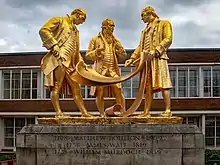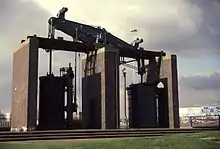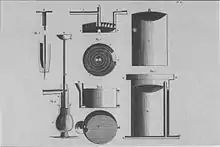Boulton and Watt
Boulton & Watt was an early British engineering and manufacturing firm in the business of designing and making marine and stationary steam engines. Founded in the English West Midlands around Birmingham in 1775 as a partnership between the English manufacturer Matthew Boulton and the Scottish engineer James Watt, the firm had a major role in the Industrial Revolution and grew to be a major producer of steam engines in the 19th century.
 Statue of Boulton, Watt and Murdoch in Birmingham | |
| Type | General partnership |
|---|---|
| Industry | Engineering, manufacturing |
| Founded | Birmingham, England (1775) |
| Founder | Matthew Boulton and James Watt |
| Defunct | c. 1895 |
Key people | Matthew Boulton James Watt William Murdoch |
| Products | Steam engines (stationary and marine) |
| Services | Engineering consulting |
The engine partnership

(Location: 52.492537°N 1.888189°W)
The partnership was formed in 1775 to exploit Watt's patent for a steam engine with a separate condenser.[1] This made much more efficient use of its fuel than the older Newcomen engine. Initially the business was based at the Soho Manufactory near Boulton's Soho House on the southern edge of the then-rural parish of Handsworth. However most of the components for their engines were made by others, for example the cylinders by John Wilkinson.
In 1795, they began to make steam engines themselves at their Soho Foundry in Smethwick, near Birmingham, England. The partnership was passed to two of their sons in 1800. William Murdoch was made a partner of the firm in 1810, where he remained until his retirement 20 years later at the age of 76. The firm lasted over 120 years, albeit renamed "James Watt & Co." in 1849, and was still making steam engines in 1895, when it was sold to W & T Avery Ltd..
Nurturing talent
The business was a hotbed for the nurturing of emerging engineering talent. Among the names which were employed there in the eighteenth century were James Law, Peter Ewart, William Brunton, Isaac Perrins, William Murdoch, and John Southern.[2]
Archive

The firm left an extremely detailed archive of its activities, which was given to the city of Birmingham in 1911 and is kept at the Library of Birmingham. The library has since obtained various other related archives.
An additional archive was donated to the Boulton and Watt collection in 2015. It represents the significant research carried out by Dr John Richardson (Accession number 2015/049) The archive includes: A copy of his completed P.h.D.thesis submitted to the University of Reading in 1989. The original thesis remains the property of the University of Reading. The archive contains: Display folders containing text and different varieties of drawings from the detailed examination of the large number of portfolios of engineering drawings. these include drawings used in the development of new ideas, detail drawings of parts, assembly drawings, drawings used in instruction and function and 'prestige' drawings often produced in full colour to provide customers with realistic views of assemblies and finished engines. Folders containing detailed handwritten notes on all portfolios examined. This information includes portfolio number, dates of drawings and comments on techniques used. Where applicable, the records cross reference with letters, books and other related literature on the firm of Boulton and Watt. A selection of DVDs containing all text and the many drawings studied are also included in the archive.
The research is primarily concerned with the contribution of the firm of Boulton and Watt to engineering drawing used in design and manufacture. The archive also includes work carried out by other early architects, artists, engineers and designers. The archive also includes information on a project undertaken in 1984. The Australian Project An opportunity arose in 1984 to evaluate the use of Boulton & Watt drawings made two hundred years earlier when Dr Richardson was asked to help the Museum of Applied Arts and Sciences, New South Wales Australia who were planning to restore and erect a Boulton and Watt engine. In the course of restoration the engine had been completely dismantled and the work revealed that the cylinder, valve gear, condenser and air pump had all been modified at least once from the original design. Reports from Australia confirmed that the engine was erected in the Power House Museum, Ultimo, New South Wales. This engine was originally designed and built for Samuel Whitbread in 1784 and the job portfolio (B & W 4) contains forty four drawings that relate to it. Copies of the different types of drawings were made and sent out; they provided all the necessary information required to re assemble and erect the engine. (Dr Louise Crossley 1984)
Preserved operational engines
- Smethwick Engine, Thinktank, Birmingham Science Museum, manufactured 1779.
- Whitbread Engine, Powerhouse Museum, Sydney, manufactured 1785, 25-inch (64 cm) bore, 72-inch (180 cm) stroke.
- Crofton Pumping Station manufactured 1812, 42 1⁄4-inch (107 cm) bore, 84-inch (210 cm) stroke.
- Kew Bridge Steam Museum manufactured 1820, 64-inch (160 cm) bore, 96-inch (240 cm) stroke.[3]
- Papplewick Pumping Station two engines, manufactured 1884, 46-inch (120 cm) bore, 90-inch (230 cm) stroke. Believed to be the last engines manufactured by the company.[4]
See also
References
- Roll, Erich (1930). An Early Experiment in Industrial Organisation : being a History of the Firm of Boulton & Watt, 1775-1805. Longmans, Green and Co. p. 320.
- Buchanan, R. A. (1978). "Steam and the engineering community in the eighteenth century". Transactions of the Newcomen Society. 50: 198.
- "The Boulton and Watt Engine". Kew Bridge Steam Museum. Archived from the original on 1 June 2008. Retrieved 8 August 2011.
- "Last engines manufactured". Papplewick Pumping Station Trust. Retrieved 7 May 2017.
Further reading
- Hills, Richard L. (2002). James Watt: His Time in Scotland (1736-1774). Landmark Publishing. ISBN 1-84306-045-0.
External links
- The Non-Rotative Beam Engine Chapter 3: The Boulton and Watt Engine Maurice Kelly ISBN 0-9536523-3-5
- Archives of Soho at Birmingham Central Library.
- Revolutionary Players website
- Cornwall Record Office Boulton & Watt letters
